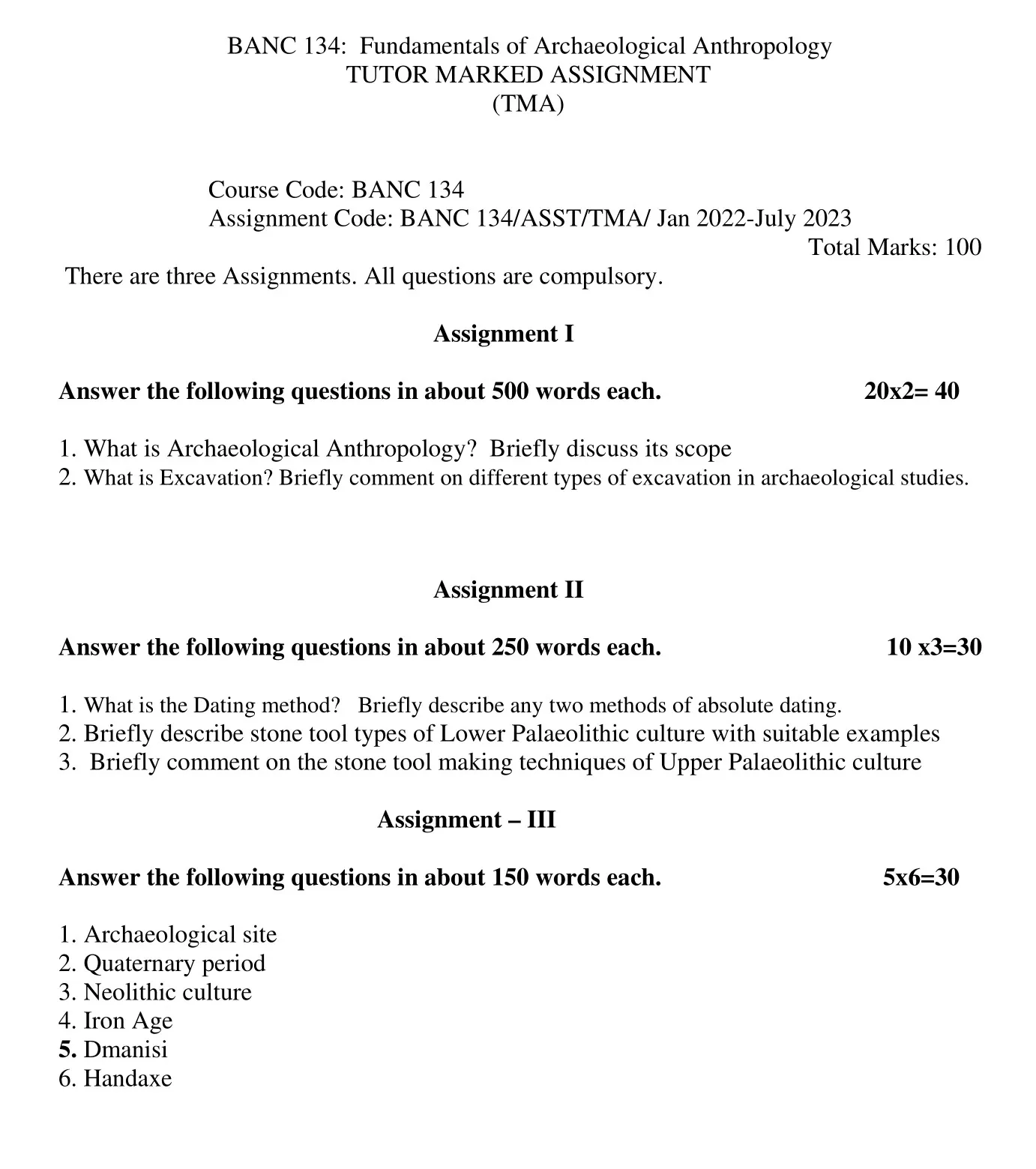Contents
- 1 Assignment I
- 2 Answer the following questions in about 500 words each. 20×2= 40
- 3 1.What is Archaeological Anthropology? Briefly discuss its scope.
- 4 2. What is Excavation? Briefly comment on different types of excavation in archaeological studies.
- 5 Assignment II
- 6 Answer the following questions in about 250 words each. 10 x3=30
- 7 3. What is the Dating method? Briefly describe any two methods of absolute dating.
- 8 4. Briefly describe stone tool types of Lower Palaeolithic culture with suitable examples.
- 9 5. Briefly comment on the stone tool making techniques of Upper Palaeolithic culture.
- 10 Assignment – III
- 11 Answer the following questions in about 150 words each. 5×6=30
- 12 6. Archaeological site
- 13 7. Quaternary period
- 14 8. Neolithic culture
- 15 9. Iron Age
- 16 10. Dmanisi
- 17 11. Handaxe

| Title | IGNOU: BANC 134 Solved Assignment 2022-2023 (FUNDAMENTALS OF ARCHAEOLOGICAL ANTHROPOLOGY) |
| University | IGNOU |
| Degree | Bachelor Degree Programme |
| Course Code | BANC 134 |
| Course Name | FUNDAMENTALS OF ARCHAEOLOGICAL ANTHROPOLOGY |
| Programme Name | Bachelor of Arts (General) |
| Programme Code | BAG |
| Total Marks | 100 |
| Year | 2022-2023 |
| Language | English |
| Assignment Code | BANC 134/ASST/TMA/ Jan 2022-July 2023 |
| Last Date for Submission of Assignment: | For June Examination: 31st March For December Examination: 30th September |

Assignment I
Answer the following questions in about 500 words each. 20×2= 40
1.What is Archaeological Anthropology? Briefly discuss its scope.
Ans: Archaeological Anthropology is a subfield of anthropology that focuses on the study of human behavior and culture through the examination of material remains and artifacts. This interdisciplinary field draws on the methods and theories of archaeology, anthropology, and various other disciplines to better understand the past and how it has shaped the present. The goal of Archaeological Anthropology is to reconstruct the ways in which human societies lived, interacted, and changed over time.
The scope of Archaeological Anthropology is broad, encompassing a wide range of topics and themes. It includes the study of human evolution, the development of early human societies, the rise of complex civilizations, and the ways in which humans have interacted with the natural environment. This field also encompasses the study of technology, economics, politics, religion, and social organization, as well as the study of human movements, migrations, and settlement patterns.
One of the key methods used by Archaeological Anthropologists is excavation. This process involves the removal of soil and other materials in order to uncover and study artifacts and other material remains. In addition, Archaeological Anthropologists also use techniques such as survey, mapping, and remote sensing to identify potential archaeological sites and to better understand their significance and context.
Another important aspect of Archaeological Anthropology is the analysis of artifacts and other material remains. This includes the study of tools, weapons, pottery, textiles, and other objects that provide insight into the lifestyles, cultures, and technological capabilities of past societies. The examination of human bones and other organic materials can also provide valuable information about diet, health, and population structure.
In recent years, the field of Archaeological Anthropology has become increasingly interdisciplinary, incorporating techniques and approaches from a variety of other disciplines, such as genetics, geology, climatology, and environmental science. This has allowed Archaeological Anthropologists to address complex questions about human behavior and cultural development that would have been difficult or impossible to answer using only traditional archaeological methods.
Overall, the scope of Archaeological Anthropology is vast and far-reaching, encompassing a wide range of topics and themes related to human behavior and cultural development. Its goal is to reconstruct the past in order to better understand the present and to shed light on the diversity of human experience. Through its interdisciplinary approach and its commitment to the scientific study of human societies and cultures, Archaeological Anthropology provides a unique and valuable perspective on the human experience.
2. What is Excavation? Briefly comment on different types of excavation in archaeological studies.
Ans: Excavation is a key method used in archaeological studies to uncover, examine, and study artifacts and other material remains. It is a process of removing soil and other materials to uncover the remains of ancient structures and artifacts, and to gather data about the cultural, historical, and social context of the site. Excavation is a critical tool for gaining insight into the past and understanding the ways in which human societies lived, interacted, and changed over time.
There are several different types of excavation used in archaeological studies, each with its own specific purpose and techniques. The most common type of excavation is site excavation, which involves the systematic removal of soil and other materials in order to uncover the remains of structures and artifacts. This type of excavation is often used to study ancient settlements, fortifications, temples, tombs, and other structures, and to gather data about the cultural and social context of the site.
Another type of excavation is stratigraphic excavation, which involves the study of soil layers and the gradual buildup of cultural materials over time. This type of excavation is used to gain a better understanding of how a site developed and changed over time, and to identify patterns in cultural development and social organization.
Salvage excavation is a type of excavation that is typically performed in response to a threat to an archaeological site, such as development or natural disaster. This type of excavation is often carried out in a hurry, and its goal is to recover as much information as possible about the site and its artifacts before they are destroyed or lost.
Underwater excavation is another type of excavation that is used to study underwater archaeological sites, such as shipwrecks, coastal settlements, and underwater structures. This type of excavation requires specialized equipment and techniques, and is often performed by archaeologists with expertise in underwater archaeology.
Finally, remote sensing excavation is a type of excavation that uses non-invasive techniques to gather data about archaeological sites. This includes methods such as aerial photography, ground-penetrating radar, and geophysical survey, which allow archaeologists to gather data about the location, size, and layout of archaeological sites without disturbing the surface of the site.
Assignment II
Answer the following questions in about 250 words each. 10 x3=30
3. What is the Dating method? Briefly describe any two methods of absolute dating.
Ans: Dating method refers to techniques used to determine the age of an object, fossil, rock, or site. It helps scientists understand the chronology of events and evolutionary processes of the natural world. There are two broad categories of dating methods: relative dating and absolute dating.
Relative dating determines the relative order of past events, but it does not provide a specific age in years. For example, stratigraphic dating is a relative dating method that uses the position of rocks and fossils in rock layers to determine the relative age of events.
On the other hand, absolute dating provides a specific numerical age for an object, fossil, or site. Some of the methods of absolute dating are:
- Radiocarbon Dating: This method is used to date organic materials like wood, bones, or shell. Radiocarbon dating is based on the decay of carbon-14, a radioactive isotope of carbon. By measuring the amount of carbon-14 remaining in a sample, scientists can determine its age.
- Potassium-Argon Dating: This method is used to date rocks that are rich in potassium, like volcanic rocks and ash. Potassium-argon dating is based on the decay of potassium-40 into argon-40. By measuring the amount of argon-40 in a sample, scientists can determine the age of the rock.
4. Briefly describe stone tool types of Lower Palaeolithic culture with suitable examples.
Ans: The Lower Palaeolithic culture, also known as the Early Stone Age, was characterized by the use of stone tools made by early human species such as Homo habilis, Homo erectus, and Australopithecus. These stone tools were used for a variety of tasks, including butchery, carving, and shaping. The stone tools of the Lower Palaeolithic can be divided into three main types: pebble tools, bifaces, and handaxes.
- Pebble Tools: Pebble tools are the earliest form of stone tools and are made by striking one stone against another to create sharp edges. An example of a pebble tool is a chopper, which was used to chop meat and plants.
- Bifaces: Bifaces are large, flattened stones that have been shaped into a sharp edge on one or both sides. They were used for cutting and scraping, and as weapons. An example of a biface is a cleaver, which was used to split bones and cut meat.
- Handaxes: Handaxes are large, symmetrical tools with a curved edge and a pointed end. They were used for a variety of tasks, including butchery, cutting, and shaping. Handaxes were the most advanced type of stone tool in the Lower Palaeolithic, and their manufacture was a complex process that required a high level of skill.
5. Briefly comment on the stone tool making techniques of Upper Palaeolithic culture.
Ans: The Upper Palaeolithic culture, also known as the Late Stone Age, was characterized by the production of more sophisticated stone tools made by early human species such as Homo neanderthalensis and Homo sapiens. This period saw a significant increase in the complexity and diversity of stone tool-making techniques compared to the Lower Palaeolithic. The following are some of the key stone tool-making techniques of the Upper Palaeolithic culture:
- Blade production: Blade production was one of the most important techniques of the Upper Palaeolithic. Blades are thin, elongated pieces of stone that were used to make a wide range of tools, such as knives, spears, and scrapers.
- Microlith production: Microliths are small, often geometric, stone tools that were used to make more complex tools, such as composite weapons and fishing gear.
- Pressure flaking: Pressure flaking is a technique that involves using a pointed tool to remove small, controlled flakes from a stone tool in order to create fine, sharp edges. This technique was used to make knives, scrapers, and other tools that required precise cutting edges.
- Levallois technique: The Levallois technique is a method of producing large, flat, symmetrical stone tools that was widely used in the Upper Palaeolithic. It involved carefully shaping the stone in a specific way, so that it could be easily flaked into a desired tool form.
Assignment – III
Answer the following questions in about 150 words each. 5×6=30
6. Archaeological site
Ans: An archaeological site is a location where evidence of human activity from the past can be found. This can include remains of structures, artifacts, and other material culture that provide insight into the lives and cultures of past societies. Archaeological sites can range in size from small, single-feature sites to large, complex settlements, and can be found both on land and underwater. The study of archaeological sites is critical for gaining a better understanding of human history and the development of human societies, as well as for preserving cultural heritage.
Archaeologists use a variety of techniques to identify, study, and preserve archaeological sites, including remote sensing, survey, excavation, and conservation. The process of excavation is particularly important, as it allows archaeologists to uncover and study the remains of structures, artifacts, and other materials in situ, providing valuable context and information about the site.
Preserving archaeological sites is critical for the preservation of cultural heritage and for future generations to learn about and understand the past. This involves not only the preservation of physical remains, but also the interpretation and interpretation of the site for the public. The study of archaeological sites is an ongoing process, and new discoveries and information are constantly being added to our understanding of the human experience.
7. Quaternary period
Ans: The Quaternary period is a time period in Earth’s history that extends from 2.58 million years ago to the present day. It is the most recent and ongoing geological time period, and is characterized by a series of major climate fluctuations, including several glacial and interglacial periods. During this time, there have been significant changes in global temperature, sea level, and other environmental conditions, which have had a profound impact on the evolution of life on Earth.
The Quaternary period is also notable for the emergence and evolution of modern humans, Homo sapiens, who have become the dominant species on the planet. During this time, humans have developed complex cultures, societies, and technologies, and have spread to virtually every corner of the world.
The study of the Quaternary period is critical for understanding the impact of climate change on the planet and for understanding the evolution of life and human society. This includes the examination of sedimentary, fossil, and other evidence to gain insight into past environmental conditions, as well as the study of human artifacts, bones, and other remains to gain insight into human evolution and behavior.
8. Neolithic culture
Ans: The Neolithic culture is a period in human history characterized by the development of agriculture and the domestication of animals. This period followed the end of the last Ice Age, around 10,000 BCE, and marked a major turning point in human history, as communities shifted from a hunter-gatherer lifestyle to one based on agriculture and animal husbandry.
Neolithic cultures are known for their development of early pottery, weaving, and the creation of stone tools, as well as the construction of large-scale architectural structures such as tombs, temples, and fortifications. The creation of settled communities allowed for the development of more complex social, political, and economic systems, and the creation of long-lasting monuments and structures helped to anchor these communities in time and space.
The Neolithic culture played a crucial role in the development of human society, and its influence can still be seen in many aspects of modern culture. The development of agriculture and animal husbandry helped to provide a more stable food supply and laid the foundation for the growth of cities, trade, and commerce.
9. Iron Age
Ans: The Iron Age was a period in human history characterized by the widespread use of iron for the production of tools, weapons, and other objects. It followed the Bronze Age and preceded the Medieval period, and is typically divided into several phases based on regional and cultural differences. The Iron Age began around 1200 BCE in the eastern Mediterranean and spread throughout Europe, Africa, and Asia over the next several centuries.
The use of iron allowed for the production of stronger and more durable tools and weapons, and facilitated the growth of trade, commerce, and the development of more complex societies. The Iron Age saw the rise of large-scale empires and the development of writing systems, as well as the construction of impressive fortifications, monuments, and religious structures.
The Iron Age is an important period in human history, as it marks a major technological and cultural shift and the development of more complex societies. The study of the Iron Age provides valuable insights into the development of early metallurgy, the growth of trade and commerce, and the evolution of human societies. The legacy of the Iron Age can still be seen in many aspects of modern culture, and its study continues to be an important area of research for archaeologists and historians.
10. Dmanisi
Ans: Dmanisi is an archaeological site located in the Republic of Georgia, and is considered one of the most important early human sites in Eurasia. The site contains a series of caves and rock shelters that were occupied by early human ancestors, and has been the subject of intense archaeological investigation since the 1980s.
The Dmanisi site is famous for the discovery of early hominin fossils, including remains of Homo erectus, and is considered one of the earliest known examples of human presence outside of Africa. The fossils found at Dmanisi provide valuable insights into the early evolution of human ancestors and their migration patterns, and suggest that early humans were capable of adapting to different environments and colonizing new territories.
The Dmanisi site also contains evidence of early human behavior, including the use of stone tools and the hunting of large game animals. The study of the site provides valuable insights into the cognitive, social, and technological capabilities of early human ancestors and their adaptation to new environments.
11. Handaxe
Ans: A handaxe is a type of large, symmetrical stone tool that was widely used during the Lower and Middle Palaeolithic eras. It is characterized by its teardrop shape, with a curved edge and a pointed end, and was used for a variety of tasks including butchery, cutting, and shaping. Handaxes were highly versatile and could be used for a range of activities, from cutting and scraping to pounding and digging.
The manufacture of handaxes was a complex process that required a high level of skill and knowledge. Raw materials were carefully selected, and the stones were shaped and flaked to create the desired form. The use of handaxes was an important step in the development of human technology, as it allowed early humans to more efficiently process food and other materials, which helped to increase their chances of survival.
Handaxes have been found in many different regions of the world, including Africa, Asia, and Europe, and are considered to be one of the most important artifacts of early human culture. They provide valuable insights into the evolution of human technology and the cultural and behavioral characteristics of early human species.
How to Download BANC 134 Solved Assignment?
You can download it from the www.edukar.in, they have a big database for all the IGNOU solved assignments.
Is the BANC 134 Solved Assignment Free?
Yes this is absolutely free to download the solved assignment from www.edukar.in
What is the last submission date for BANC 134 Assignment?
For June Examination: 31st March, For December Examination: 30th September
















